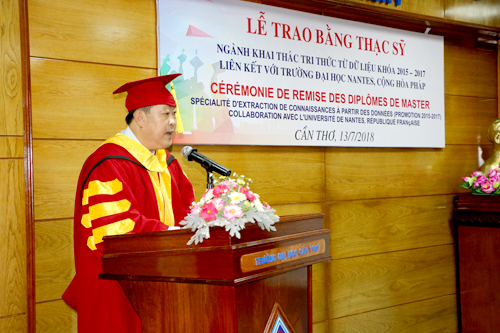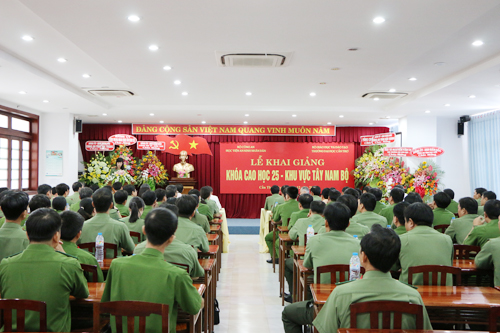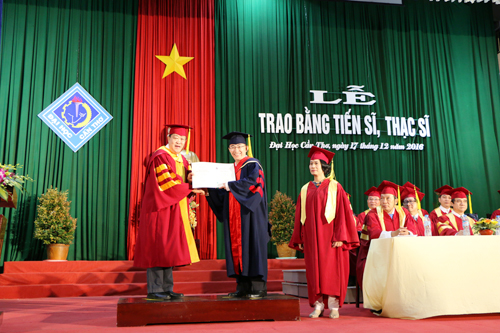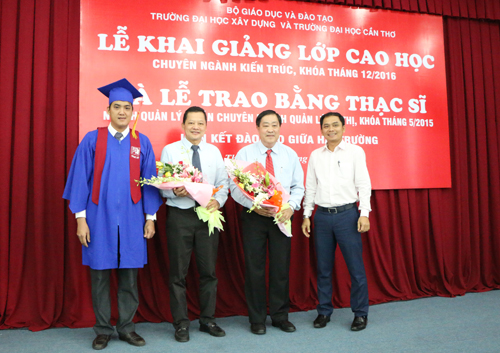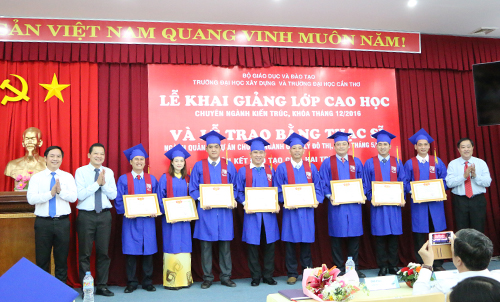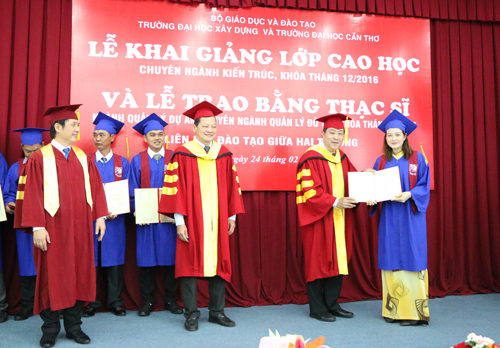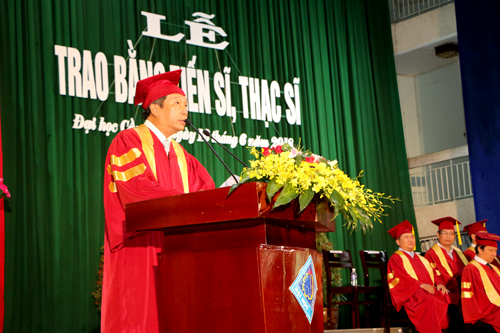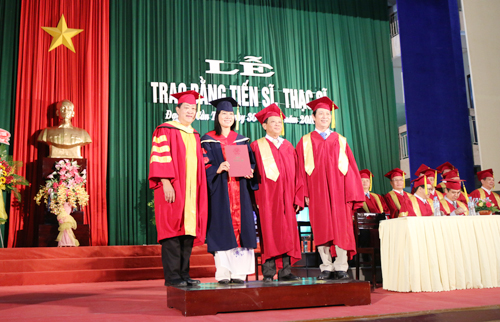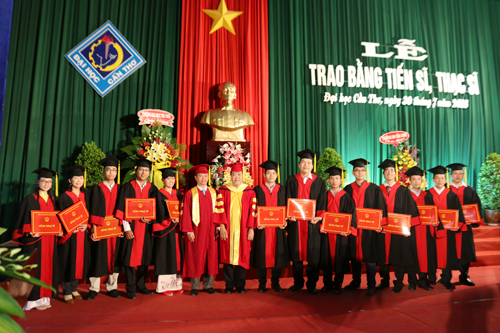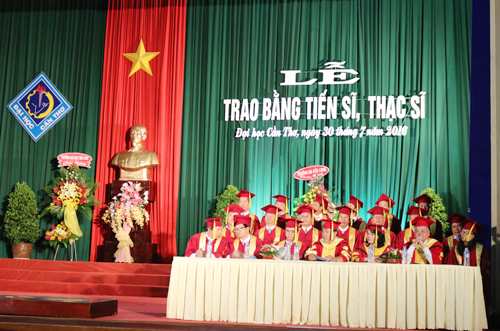
Tên đề tài: "Sử dụng phân hữu cơ vi sinh từ nguồn nấm phân lập trong cải thiện bạc màu đất và năng suất cam sành tại huyện Tam Bình, tỉnh Vĩnh Long”.
Tác giả: Nguyễn Ngọc Thanh, Khóa: 2014
Chuyên ngành: Khoa học đất; Mã số: 62620103. Nhóm ngành: Nông, lâm nghiệp và thuỷ sản.
Người hướng dẫn chính: GS.TS. Võ Thị Gương - Trường Đại học Tây Đô
Người hướng dẫn phụ: TS. Dương Minh Viễn - Trường Đại học Cần Thơ
- Tóm tắt nội dung luận án
Kết quả khảo sát và đánh giá các đặc tính đất vườn cam sành (Citrus nobilis) ở huyện Tam Bình, tỉnh Vĩnh Long xác định được các vấn đề ảnh hưởng bất lợi đến canh tác cây cam sành: (1) Đất vườn trồng cam suy giảm độ phì nhiêu đất: pH đất thấp, nghèo chất hữu cơ, bón phân N, P và K không cân đối (bón dư thừa N, P, nhưng lại thiếu hụt K trong đất); (2) Tỷ lệ bệnh vàng lá thối rễ cao trên vườn cam sành; (3) Năng suất trái vườn cam sành giảm thấp.
Kết quả nghiên cứu xác định được tác nhân gây bệnh vàng lá thối rễ trên vườn cam sành do nấm Fusarium solani.
Kết quả nghiên cứu khẳng định hiệu quả của phân hữu cơ vi sinh được ủ với nấm Trichoderma asperellum (được phân lập tại vùng rễ cây cam sành) và nấm Gongronella butleri (vi sinh vật tăng nhanh khả năng phân hủy chất hữu cơ) giúp cải thiện có ý nghĩa đặc tính hóa học đất (pH đất, CHC, C-labile, N-labile, Nhd, Phd, Ktđ, CEC và độ bảo hòa base đất), cải thiện đặc tính sinh học đất như tăng tổng mật số vi sinh vật đất, giảm mật số nấm Fusarium sp.
Tác động của phân hữu cơ vi sinh giúp giảm bệnh vàng lá thối rễ trên cam sành. Tỷ lệ giảm bệnh 33%- 36% sau 15 tháng bón phân hữu cơ vi sinh. Năng suất trái vườn cam sành tăng có ý nghĩa. Năng suất trái tăng thêm từ 94-257% ở vụ thu hoạch trái thứ nhất và tăng từ 198-311% ở vụ thu hoạch trái thứ hai.
Trên cơ sở kết quả nghiên cứu, liều lượng phân hữu cơ vi sinh được khuyến cáo sử dụng là 8kg/cây kết hợp phân vô cơ theo khuyến cáo giúp cải thiện độ phì nhiêu đất, giảm bệnh vàng lá thối rễ, tăng năng suất trái vườn cam sành.
- Những kết quả mới của luận án
Kết quả nghiên cứu đã cho thấy khả năng sử dụng nguồn nguyên liệu rơm sẵn có tại địa phương và vi sinh vật bản địa có lợi để tạo thành phân hữu cơ vi sinh, tác động hiệu quả đến cải thiện đặc tính lý, hóa và sinh học đất, đồng thời giúp giảm mật số nấm Fusarium sp. trong đất, giảm bệnh vàng lá thối rễ trên vườn cam sành.
Kết quả nghiên cứu cung cấp cơ sở khoa học cho việc sản xuất phân hữu cơ vi sinh với dòng nấm phân lập ở vùng rễ cam sành (Trichoderma asperellum và Gongronela butleri) có hiệu quả cao trong cải thiện sự bạc màu đất liếp vườn cam sành, giảm bệnh vàng lá thối rễ và tăng năng suất trái.
- Kết luận chung
Hiện trạng canh tác vườn cam sành trên đất liếp vườn lâu năm có độ phì nhiêu đất giảm, tỷ lệ bệnh vàng lá thối rễ cao. Đất vườn canh tác cam sành trên 15 năm tuổi suy giảm độ phì nhiêu đất, các đặc tính đất CHC, Nhd, Phd, Ktđ trong đất giảm thấp so với đất canh tác ít năm tuổi (P<0,05).
Vườn cam sành bị bệnh vàng lá thối rễ có ẩm độ đất cao, hàm lượng CHC, Nhd, Ktđ thấp hơn so với vườn cam không bệnh (P<0,05). Nấm Fusarium solani là tác nhân gây bệnh vàng lá thối rễ trên vườn cam sành.
Bón phân hữu cơ vi sinh được ủ từ rơm rạ được chủng với nấm Trichoderma asperellum, Gongronella butleri có ý nghĩa trong tăng năng suất trái vườn cam sành. Phân hữu cơ vi sinh được chủng nấm Trichoderma asperellum và Gongronella butleri giúp giảm bệnh vàng lá thối rễ, giảm 36% tỷ lệ bệnh, do giảm mật số nấm Fusarium sp., tăng tổng mật số vi sinh vật trong đất so với canh tác chỉ bón phân vô cơ. Một số đặc tính vật lý, hóa học và sinh học đất vườn cam sành được cải thiện có ý nghĩa qua tăng hàm lượng C hữu cơ dễ phân hủy, Nhd, N hữu cơ dễ phân hủy, Phd, Ktđ, phần trăm base bảo hòa, pH đất, độ bền cấu trúc đất so với canh tác theo nông dân.
Thesis title: Using bio-organic fertilizers from isolated fungus strains in improving soil degradation and citrus (Citrus nobilis) fruit yield in Tam Binh district, Vinh Long province
Specialization: Soil science Code: 62620103
Full name of PhD student: Nguyen Ngoc Thanh Course: 2014 (second time)
Full name of scientific Supervisor: Prof. Dr. Vo Thi Guong
Full name of co-supervisor: Dr. Duong Minh Vien
Training facilities: Can Tho University
- Summary of thesis
Surveying the present situation of citrus orchards (Citrus nobilis) in Tam Binh district, Vinh Long province indicated problems confronted on citrus cultivation: (1) Soil degradation such as low pH, poor in soil organic matter, unbalanced of N, P and K fertilization (high dose of N, P but limit of K application); (2) High rate of root rot disease; (3) Very low fruit yield.
Our study found out that Fusarium solani. was the major cause of the root rot disease on Citrus nobilis orchards.
Using the bio-organic fertilizers with Trichoderma asperellum (isolated at citrus rhizosphere soil), and Gongronella butlerium fungi (enhancing the decompose of organic matter) showed positive effect in improving of soil properties as increasing of soil pH, soil organic matter content, labile organic C, labile organic N, available N, available P, exchangeable K, CEC, base saturation and total soil microbes and reducing of Fusarium sp. density. As results, the the bio-organic fertilizers in combination with recommended inorganic fertilizers led to decrease of the root rot disease ratio on the Citrus nobilis orchards from 33%-36% after fifteen months of amendment. Fruit yield was recorded greatly increasing by 94-257% in the first crop and by 198-311% in the second crop.
Bases on the above results, to improve soil fertility, reduce of the root rot disease, and increase the fruit yield of the Citrus nobilis orchards, recommendation was given to farmers for amending of 8 kg per tree of the bio-compost in combined with balanced dose of inorganic fertilizers.
- New contributions from the results of thesis
The research showed positive effect of using available materials and beneficial native fungi resulted on improvement of soil physical, chemical and biological characteristics and reducing of Fusarium sp. density in soil, contributed on controlling of root rot disease on the citrus orchards.
Our study provided the scientific basic for producing the bio-organic fertilizers with isolated fungus from native rhizosphere soil that improved significantly soil degradation on citrus orchards, controlling root rot disease and increased fruit yield.
- General conclusions
Evaluating current situation of the Citrus nobilis orchards indicated that soil fertility declined, high ratio of the root rot disease and low fruit yield. The raised bed of over 15 years old showed a soil degradation in soil organic matter, available nitrogen, phosphorus, exchangeable potassium (P<0.05).
The citrus orchards infected of the root rot disease displayed high soil moisture, a lower soil organic matter content, poor in available nitrogen, phosphorus, exchangeable potassium compared to those non-infected disease (P<0.05). Fusarium solani was identified as the major agent causing root rot disease on the Citrus nobilis orchards.
Applying of the bio-organic fertilizers with inoculating fungus Trichoderma asperellum, Gongronella butleri resulted in decreasing by 36% of the root rot disease from reducing density of Fusarium sp. and increasing total soil microorganism in soil compared to farmers’ practice. Amendment of the bio-organic fertilizers led to improve some selected soil properties of the orchards raised beds as increasing soil organic matter content, labile organic C, available nitrogen, labile organic N, available phosphorus, exchangeable potassium, base saturation, soil pH, soil aggregate stability. As the above important results, fruit yield was greatly increased.
- Xem chi tiết nội dung luận án
- Xem thông tin đăng tải tại Website Bộ giáo dục và Đào tạo. (Nhập tên NCS vào ô tìm kiếm)





